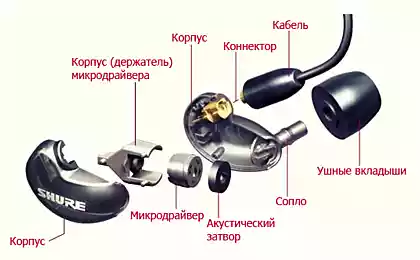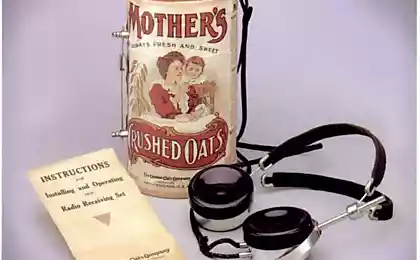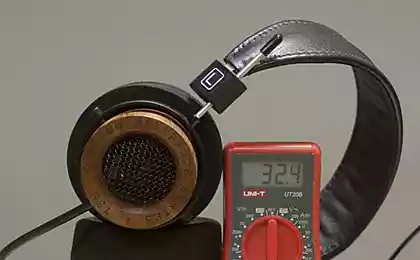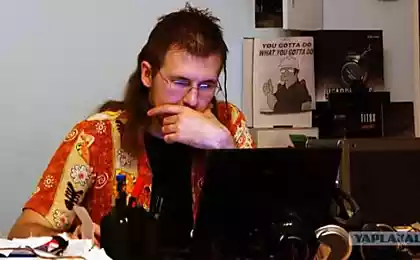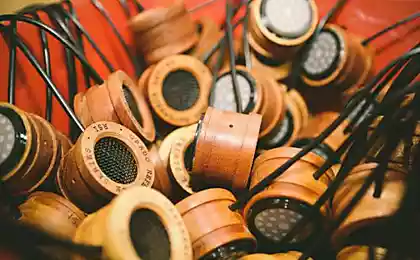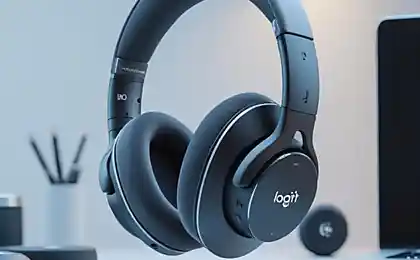1927
Armature headphones with balanced armature - differences and especially against other types of emitters in headphones
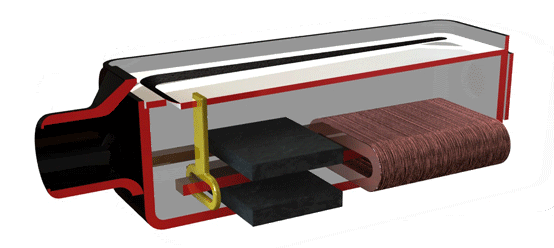
We have long been accustomed to, that of the headphones the speakers for sound radiation and often do not pay attention, that there are other types of emitters.
In English, the word «driver» means "radiator". Due to the dominant use of dynamic emitters many put equality between the words «driver» and "speaker" that just competently as to assert that "fuel" and "petrol" - the same thing.
In addition to dynamic emitters, there are alternatives: rebar, electrostatic, i- and ortho-dynamic transducers.
Armature transducers are widely used recently and occupy almost an equal number of models with dynamic headphones in the middle and upper end of the In-ear monitor.
Valve radiator originally referred to as «balanced armature» and has no exact translation. Typically used as the name of headphones with this emitter:
- Armature headphones
- Headphones with balanced armature
- Headphones with balanced armature
- A balanced armature
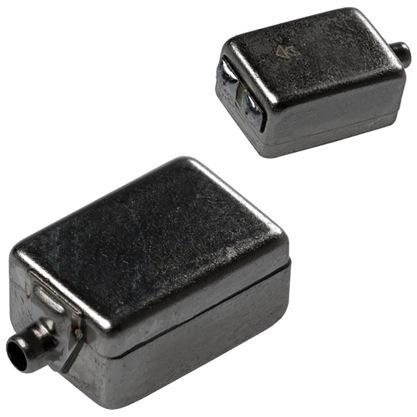
Valve radiator looks like an elongated rectangular bottle, where the sound is emitted from the bottle. Thus, the axis coincides with the main radiation length, width and height of the relatively small radiator. This form of this type of transducer is widely used in ITE hearing aids, where conventional dynamic transducer is impossible to place in the narrow ear canal.

Marketers like to compare different companies and the size of the reinforcing dynamic emitter, showing that rebar much smaller radiator, and plays just as well.
But the laws of physics can not fool all the parameters that depend on the size, valid for reinforcing the emitter: small size - this restriction bass and overload capacity of the radiator.
Whatever reinforcing the headphones are not inferior to dynamic overload capacity at low frequencies, or use requires reinforcing the radiator with comparable dimensions, or use multiple emitters.
Like any emitter, rebar or dynamic, the very type of determination is not synonymous with quality or binding characteristics. There are low-end models with mediocre sound, and there are expensive and very expensive with high quality sound. It is pointless to compare cheap reinforcing dynamic headphones with expensive and vice versa. Preference will often be in the side of the road model, regardless of the type of the radiator.
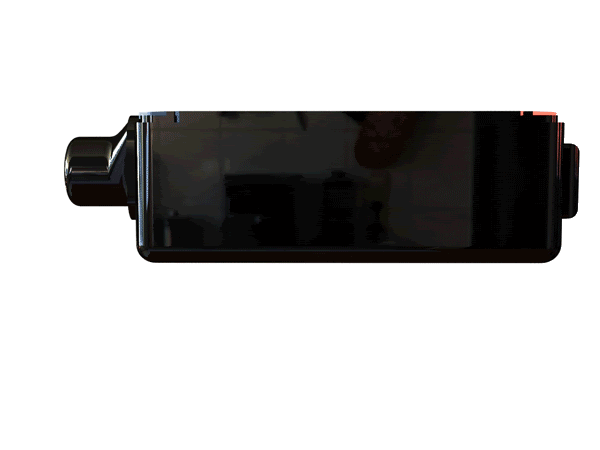
Constructively with the same area of the membrane at reinforcing and dynamic emitter move more in the dynamic membrane. For this reason, the dynamic emitters higher overload capacity, which is expressed in the absence of cod in sound at high volume. When the task is to get the same bass as in the dynamic transducer using reinforcement - takes a lot of the total area of the reinforcing emitter (compensating slow speed of the membrane).
A further disadvantage of many reinforcing emitters is the narrow neck, which adds distortion at low frequencies due to the inability to "pump" the necessary amount of air. The neck is required for attachment of the sound in hearing aids. Probably for this reason that the reinforcing emitters company SONY (which does not release their radiators under hearing aids) there is no neck.
Development of reinforcing headphones
In the history of origin of reinforcing headphones most vibrant role played by Jerry Harvey.
Reinforcing emitters while mainly used in hearing aids. If the hearing impaired was important only midrange (hear speech of others) and high volume, the musicians and audiophiles needed a wide frequency range, high overload capability and the best sound quality. This required an entirely different approach.
In 1995, Gerry Harvey created the first custom monitors for musicians, laying the foundation for the development of mnogodrayvernyh models. Custom monitors is an analog hearing aid with a high sound insulation for stage performance. Corpus custom headphones (like hearing aids) is made individually by a cast of the ear, which provides secure fit and the best noise isolation. Musicians custom monitors are referred to as personal in-ear monitoring system.
Using multiple emitters possible to obtain high-quality audio and escape from the level of "hearing aids". Gradually successful custom model moved into the universal headphones and now widespread.
Earlier, in 1991 Etymoic presented model ER-4 (still enjoying high demand among odnodrayvernyh models). However, the model ER-4 with one transmitter is designed primarily for audiophiles.
Among audiophiles there are many adherents as odnodrayvernyh models (no filter and therefore less phase distortion) and mnogodrayvernyh model (more phase distortion due to filters, but with the advantage on any other parameter: overload capacity, deep bass, and so upbeat it dry.).
Many emitters and sound quality
Recently, manufacturers try to accommodate as much as possible reinforcement emitters in the earpiece, hinting that more emitters, the higher the quality. To date, among the mass of products number of drivers is 6 pcs. In no mass and Custom earphones number of drivers reach 12 pcs or more (for example JH Audio Layla).
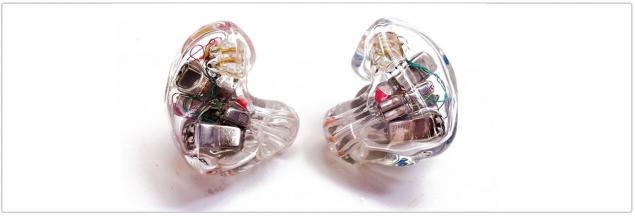
Custom headphones with "only" 8 emitters i>
A large number of emitters are not always provide as the gain and creates problems with the final dimensions of the headphone is limited in mass production of a number of headphones 3 emitters. In most cases, with dimensions comparable with trehdrayvernoy model, 6-driver model simply uses the smaller size reinforcing emitters. For example at 6 Westone W60 uses emitters, but three bands to reproduce, and on each strip use two identical emitter. The cost of this approach increases the quality is not proportional.
When it comes to Custom models, often from a cast of the ear is determined by the maximum number of emitters can be used and what model of headphones are automatically excluded.
What is the use of real models with a lot of drivers?
In concert monitors try due to the large number of emitters to raise the sensitivity of headphones, which in turn provides a loud sound even from weak sources (you never know with any equipment on stage have to work).
Normally, if a user takes an ordinary concert monitors, we often begin to complain about the background noise can be heard clearly from the source (eg phone). Most companies developing mnogodrayvernye model guided by musicians and for this reason it is necessary to meticulously in choosing mnogodrayvernyh headphones - the result is not often coincide with expectations. Most concert monitors are designed to operate in noisy environments and in a less noisy environment perceived deaf. In this case, the transition from traditional models with three emitters is not conducive to the transition to a new level of quality, but only empties the purse.
For audiophiles, you must configure the radiators so that they would work in the lite mode with low distortion at normal sensitivity headphones.

In addition to the quantity and quality of the sound emitters strongly influenced filters (krosoovery) separating the audio stream into separate frequency bands. Because of the impossibility of using large inductors and capacitors, crossover and selection of the emitters is very expensive part in the design and sometimes affects the overall quality higher than the quality of emitters separately. Headphones with a large number of emitters and low price (albeit seemingly adequate for the total price of components) can significantly inferior eminent models, with a seemingly simpler element base.
As for the choice between Custom and standard headphones with comparable components from a single source, the individual body usually costs from $ 200 to $ 500.
Round fittings
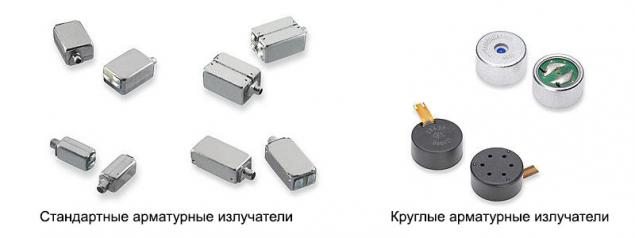
Separate species reinforcing emitters is cylindrical bars, many well-known for the title of the first successful series Siren Armature. Round shape repeats dynamic transducers and competes with them only due to the quality or nature sounds. The main advantage is the high sensitivity and the absence of filler. Today, with a circular armature can be found mainly odnodrayvernye high-end models (such as Grado GR8 and GR10 ). In most cases, headphones with a circular armature demonstrate neutral and smooth sound with high detail. What is interesting in Grado GR10 is positioned above the GR8, although the same class headphone and model different tonal balance, GR8 have a "dark" sound and GR10 more "light".
If earlier odnodrayvernye headphones with broadband reinforcing emitters were many de facto standard quality (Etymoic ER-4, Klipsh X10, etc.), the headphones with a circular armature quite confidently pushed the leading place.
Models with younger emitters round fixtures are not accustomed to the market (S-Jays, Fischer Audio SBA-1), as obvious advantages over conventional balanced armature speaker or not. Applications for a "Siren Armature" as guarantor of the quality of enthusiasm among consumers has not caused because were high expectations among different groups. Headphones are not able to compete with the reinforcement Etymoic ER-4 and Klipsh X10 to detail, and dynamic models for quality.
Advantages and disadvantages of reinforcing emitter
Benefits
- Most emitters do not require a separate chamber (equivalent volume). This allows the use of any form of housing headphones.

The hybrid system requires a separate chamber under the speaker and therefore repeats the traditional ergonomics dynamic models.
Features
If the resistance value of dynamic headphones indirectly affects the sensitivity to voltage and high-impedance headphones are classified as "quiet and unsuitable for portable", then reinforcing headphone no such connection. Resistance can reach up to hundreds of ohms and compete in terms of volume with dynamic headphones with impedance of 16 ohms. Do mnogodrayvernyh reinforcing headphone line impedance may have a high dispersion of peaks and valleys and therefore require high-quality amplifier for realizing the potential of headphones. Depending on the nature of the impedance headphone amplifier and the final frequency response of headphones will change.
The quality and type of radiator
Armature headphones are often considered of higher quality, but it is important not to fall for some manipulation.
Flat frequency response
Because of the low overload capability majority reinforcing headphones has no lift at low frequencies, which provides a flat frequency response (technically correct). In certain cases, it can be classified as a high quality - this is a more accurate tonal balance and often "quick and articulate" bass. However, there is a psycho-acoustic tonal adjustment to the ear, similar to the tuning of the white balance. In addition, on the street and transport rise in the low frequency region compensates for low frequency hum around so dynamic headphones for streets in high demand.
Flat frequency response exists not only in reinforcing the headphones, including dynamic headphones, there are exceptions to the rule in the form of "no bass" models like Hifiman ReZero, Re 100/400.
But all things being equal, if necessary, select the headphones with "flat" frequency response reinforcing odnodrayvernye headphones preferable because amplifier is easier to work out medium- and high-frequency range from reinforcing the headphones and get to the exit, respectively, less distortion.
The most expensive headphones - reinforcing, and therefore the best
Among the most expensive models of headphones can be seen in the main reinforcement model. The high cost is dictated by the quantity, quality (value) emitters and filter settings.
Mnogodrayvernye dynamic model in most cases can not be done due to the geometry of the emitters and dynamic requirement to the housing. It provides leadership among the most expensive headphones reinforcement models. But the notion of "best" applies only within its price range, and not on all models.
Audiophile preference
Ideological battles, it is better to go for a long time and not going to stop. Someone in the collection holds several models of headphones mood or a particular genre of music. Other preferences are temporary in nature, a couple of years "fittings", then "I am tired of bland sound, I want meat," the transition towards dynamic headphone and back after the statement "tired of pecking bass, I want to relax." Everything is amplified, "transistor" or "lamp».
Conclusion
Valve radiator is a full alternative to dynamic radiator. Due to the design features, body headphone reinforcing emitters can be of arbitrary shape and allows the use of mnogodrayvernoy system.
The sound quality depends on the specific model, but due to the fact that the roots of reinforcing the headphones go in the professional sphere, in most cases, reinforcing the headphones have a more natural sound. Dynamic Headphones (in its price range) leading to a depth of bass and high overload capacity, because of what is in high demand for the street.
Seasoned audiophiles often kept in the collection of different types of headphones or change them periodically. What kind of headphones do you use? I use mostly (intracanal) headphones reinforcing headphones dynamic headphones hybrid < / do not use In-ear monitor Voted 364 people. 78 people abstained. Only registered users can vote in polls. Sign , please.
Source: geektimes.ru/company/soundpal/blog/249418/






